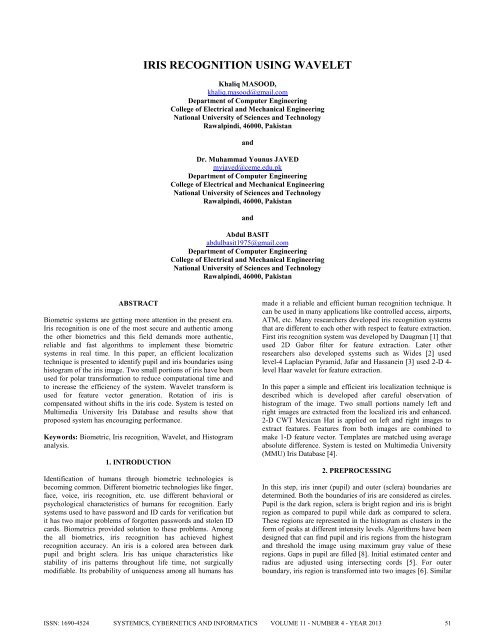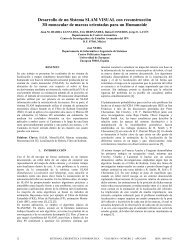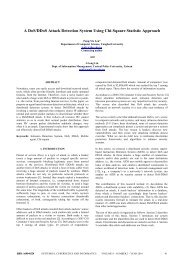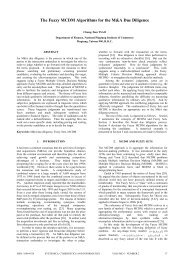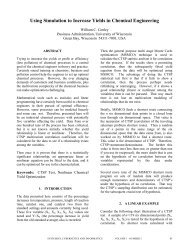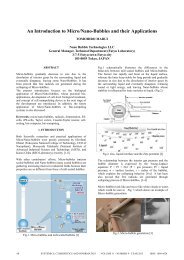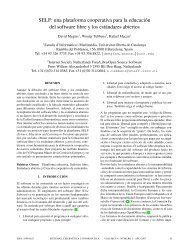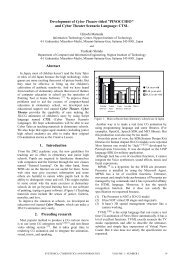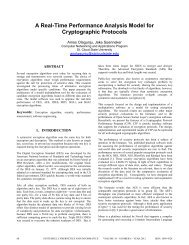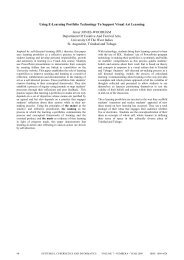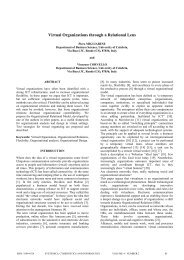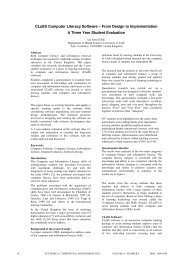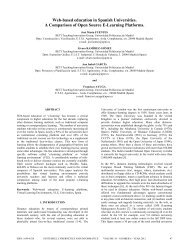IRIS RECOGNITION USING WAVELET
IRIS RECOGNITION USING WAVELET
IRIS RECOGNITION USING WAVELET
You also want an ePaper? Increase the reach of your titles
YUMPU automatically turns print PDFs into web optimized ePapers that Google loves.
<strong>IRIS</strong> <strong>RECOGNITION</strong> <strong>USING</strong> <strong>WAVELET</strong><br />
Khaliq MASOOD,<br />
khaliq.masood@gmail.com<br />
Department of Computer Engineering<br />
College of Electrical and Mechanical Engineering<br />
National University of Sciences and Technology<br />
Rawalpindi, 46000, Pakistan<br />
and<br />
Dr. Muhammad Younus JAVED<br />
myjaved@ceme.edu.pk<br />
Department of Computer Engineering<br />
College of Electrical and Mechanical Engineering<br />
National University of Sciences and Technology<br />
Rawalpindi, 46000, Pakistan<br />
and<br />
Abdul BASIT<br />
abdulbasit1975@gmail.com<br />
Department of Computer Engineering<br />
College of Electrical and Mechanical Engineering<br />
National University of Sciences and Technology<br />
Rawalpindi, 46000, Pakistan<br />
ABSTRACT<br />
Biometric systems are getting more attention in the present era.<br />
Iris recognition is one of the most secure and authentic among<br />
the other biometrics and this field demands more authentic,<br />
reliable and fast algorithms to implement these biometric<br />
systems in real time. In this paper, an efficient localization<br />
technique is presented to identify pupil and iris boundaries using<br />
histogram of the iris image. Two small portions of iris have been<br />
used for polar transformation to reduce computational time and<br />
to increase the efficiency of the system. Wavelet transform is<br />
used for feature vector generation. Rotation of iris is<br />
compensated without shifts in the iris code. System is tested on<br />
Multimedia University Iris Database and results show that<br />
proposed system has encouraging performance.<br />
Keywords: Biometric, Iris recognition, Wavelet, and Histogram<br />
analysis.<br />
1. INTRODUCTION<br />
Identification of humans through biometric technologies is<br />
becoming common. Different biometric technologies like finger,<br />
face, voice, iris recognition, etc. use different behavioral or<br />
psychological characteristics of humans for recognition. Early<br />
systems used to have password and ID cards for verification but<br />
it has two major problems of forgotten passwords and stolen ID<br />
cards. Biometrics provided solution to these problems. Among<br />
the all biometrics, iris recognition has achieved highest<br />
recognition accuracy. An iris is a colored area between dark<br />
pupil and bright sclera. Iris has unique characteristics like<br />
stability of iris patterns throughout life time, not surgically<br />
modifiable. Its probability of uniqueness among all humans has<br />
made it a reliable and efficient human recognition technique. It<br />
can be used in many applications like controlled access, airports,<br />
ATM, etc. Many researchers developed iris recognition systems<br />
that are different to each other with respect to feature extraction.<br />
First iris recognition system was developed by Daugman [1] that<br />
used 2D Gabor filter for feature extraction. Later other<br />
researchers also developed systems such as Wides [2] used<br />
level-4 Laplacian Pyramid, Jafar and Hassanein [3] used 2-D 4-<br />
level Haar wavelet for feature extraction.<br />
In this paper a simple and efficient iris localization technique is<br />
described which is developed after careful observation of<br />
histogram of the image. Two small portions namely left and<br />
right images are extracted from the localized iris and enhanced.<br />
2-D CWT Mexican Hat is applied on left and right images to<br />
extract features. Features from both images are combined to<br />
make 1-D feature vector. Templates are matched using average<br />
absolute difference. System is tested on Multimedia University<br />
(MMU) Iris Database [4].<br />
2. PREPROCESSING<br />
In this step, iris inner (pupil) and outer (sclera) boundaries are<br />
determined. Both the boundaries of iris are considered as circles.<br />
Pupil is the dark region, sclera is bright region and iris is bright<br />
region as compared to pupil while dark as compared to sclera.<br />
These regions are represented in the histogram as clusters in the<br />
form of peaks at different intensity levels. Algorithms have been<br />
designed that can find pupil and iris regions from the histogram<br />
and threshold the image using maximum gray value of these<br />
regions. Gaps in pupil are filled [8]. Initial estimated center and<br />
radius are adjusted using intersecting cords [5]. For outer<br />
boundary, iris region is transformed into two images [6]. Similar<br />
ISSN: 1690-4524<br />
SYSTEMICS, CYBERNETICS AND INFORMATICS VOLUME 11 - NUMBER 4 - YEAR 2013<br />
51
steps are performed to find threshold point. Three points are<br />
calculated on outer iris boundary to find center and radius.<br />
Inner Iris Boundary Detection<br />
By observing an eye image, it can be seen that pupil is a dark<br />
region. To detect inner iris boundary, following steps are<br />
performed:<br />
a. Find First Significant Peak<br />
First significant peak of the histogram of image is selected that<br />
represents majority of pupil area pixels. This peak always lies in<br />
low intensity values.<br />
b. Move k Local Minima Forward<br />
In order to find full region of pupil, intensity value is shifted k<br />
local minima forward as shown in Figure 1(b). The value of k is<br />
determined through experiments. On MMU, value of k is 7.<br />
Minima is defined as:<br />
(freq(i-1)>=freq(i)) && (freq(i)
These factors can severely affect iris matching results. In order<br />
to get accurate results, it is necessary to eliminate these factors.<br />
To achieve this, localized iris is transformed into polar<br />
coordinates system. The Cartesian to polar transformation was<br />
suggested by Daugman [1]. Localized iris is transformed into a<br />
rectangular block of size to achieve size independent iris<br />
recognition and this process helps to improve recognition<br />
results. 48x448 resolution size is used for whole iris.<br />
Whole iris [0,360 o ] is not transformed in the proposed system<br />
because of the fact that most of the irises are affected by upper<br />
and lower eyelids. Experiments were conducted by normalizing<br />
the iris from [60,120 o ] and [240,300 o ], ignoring both upper and<br />
lower eyelid areas as indicated in Figure 3. Size of rectangular<br />
block is reduced accordingly. Left and right images of size<br />
48x74 are obtained. By applying this approach, detection time of<br />
upper and lower eyelids and 66% cost of the polar<br />
transformation is saved. Results have shown that information in<br />
these portions of iris is good enough for iris recognition.<br />
Right image<br />
Image Enhancement<br />
Left image<br />
Figure 3: Ignoring upper and lower eyelids<br />
In order to obtain best features for iris recognition, polar<br />
transformed image is enhanced using contrast-limited adaptive<br />
histogram equalization [9] on left and right images separately.<br />
Results of image before and after enhancement are shown in<br />
Figure 4.<br />
systems. Different experiments were conducted and Haar,<br />
Symlet, Biorthogonal and Mexican hat wavelets were used to<br />
extract features. Recognition results obtained from experiments<br />
using different wavelets are shown in Figure 5. Approximation<br />
coefficients at Level-1 of Haar, Symlet and Biorthogonal have<br />
been used as features while YAWTB’s [7] CWT function is<br />
used to implement the Mexican hat at scale 4 and decomposed it<br />
to get features. Wavelets are applied separately on left and right<br />
images and then combined to make 1D feature vector.<br />
4. MATCHING<br />
Matching value of two iris codes is calculated on the basis of<br />
their average absolute differences. Iris codes with minimum<br />
matching value are considered as best match. Matching value is<br />
calculated as:<br />
1 m<br />
MV = ∑ DBi<br />
NCi<br />
m i=<br />
1<br />
−<br />
(2)<br />
Where m is the length of the feature vector. DB is the iris<br />
code stored in the database and NC is the new iris code to be<br />
matched in the database. Corresponding values in the codes are<br />
matched and matching value (MV) is computed. Database code<br />
that produces minimum matching value with new code is<br />
considered as matched subject. If matching value is smaller than<br />
separation point then it is considered matched otherwise it is not<br />
matched.<br />
No shifts in the iris code were used. Only average is used to<br />
compensate rotation of iris that reduced the number of iris codes<br />
stored in the database and increase the speed of matching<br />
process to some extent.<br />
5. EXPERIMENTS AND RESULTS<br />
The proposed system has been developed in Matlab 7 and using<br />
P-IV 3.2 GHz system available in the department laboratory and<br />
has been tested on 410 images from 82 classes of MMU iris<br />
image database. Two types of experiments have been conducted<br />
to test the performance of the system.<br />
Before<br />
After<br />
(a) Left image<br />
In the first experiment, randomly selected three images of 72<br />
classes (216 images) and their average were used for training<br />
purpose and two images of these 72 classes (144 images) were<br />
used for matching while 10 classes (50 images) were also used<br />
in matching process as imposter.<br />
Before<br />
After<br />
(b) Right image<br />
Figure 4: (a) Left image before and after enhancement. (b) Right<br />
image before and after enhancement<br />
3. FEATURE EXTRACTION<br />
Feature extraction is the most important part in recognition<br />
In the second experiment, only average of randomly selected<br />
three images of 72 classes (216 images) was used for training<br />
purpose to reduce the number of codes in the database and all<br />
images of these 72 classes (360 images) were used for matching<br />
while 10 classes (50 images) were also used in matching process<br />
as imposter.<br />
Selection of separation point is critical. If small separation point<br />
is selected there will be less False Acceptance Rate (FAR) and<br />
more False Rejection Rate (FRR). By increasing the value of<br />
separation point more FAR and less FRR will be achieved.<br />
There must be a trade off between FAR and FRR. Receiver<br />
Operating Characteristic (ROC) curve is used as a standard to<br />
ISSN: 1690-4524<br />
SYSTEMICS, CYBERNETICS AND INFORMATICS VOLUME 11 - NUMBER 4 - YEAR 2013<br />
53
check the performance of the proposed system. The curves in<br />
Figure 5 show all possible system states of FAR and FRR. In<br />
case of a perfect system, this curve should be a straight line<br />
along axis. On the other cases this curve should pass as near as<br />
possible to the origin of FAR and FRR. Equal Error Rate (EER)<br />
means a point on the graph where FAR and FRR are equal.<br />
Minimum EER of a system means better recognition. Figures 5<br />
and 6 show comparison of ROC curves of different wavelets<br />
used for feature extraction, obtained during experiments 1 and 2<br />
respectively.<br />
False Rejection Rate<br />
False Rejection Rate<br />
False Acceptance Rate<br />
Figure 5: ROC curves of experiment 1<br />
False Acceptance Rate<br />
Figure 6: ROC curves of experiment 2<br />
ROC curves of first experiment show that Mexican Hat has<br />
minimum EER as compared to other wavelets. In experiment 1,<br />
ROC curves of Haar and Biorthogonal are exactly the same.<br />
EER of Haar, Symlet 2 and Biorthogonal 1.1 is same i.e. 0.08<br />
and EER of Mexican Hat is 0.041.<br />
Similar observations have also been noted in the ROC curves of<br />
experiment 2 for Haar, Symlet, Biorthogonal and Mexican Hat<br />
wavelets. EER values of Haar, Symlet and Biorthogonal have<br />
reduced as compared to the results of experiment 1 whereas it<br />
has increased by 0.0054 in case of Mexican Hat. EER of Haar,<br />
Symlet 2, Biorthogonal 1.1 and Mexican Hat are 0.063, 0.061,<br />
0.063 and 0.0464 respectively.<br />
Results presented in Figures 5 and 6 show that Mexican Hat<br />
provided best results with minimum EER in both experiments<br />
because it is very useful to detect variations in the signal and<br />
therefore it is more suitable in iris recognition. EER of Mexican<br />
Hat in both experiments is relatively similar that shows its<br />
consistency over recognition results while EER of other<br />
wavelets has more variations because of which their recognition<br />
rate is lower than Mexican Hat.<br />
Recognition rates obtained in two experiments using different<br />
wavelets are shown in Table 1. Mexican Hat produced better<br />
results as compared to other wavelets.<br />
Recognition Rate<br />
Wavelet<br />
Experiment 1 Experiment 2<br />
Haar 92% 93.7%<br />
Symlet 92% 93.9%<br />
Biorthogonal 92% 93.7%<br />
Mexican Hat 95.9% 95.36%<br />
Table 1: Recognition rate comparison<br />
Average time of the iris recognition system is shown in Table 2<br />
which indicates that the developed system can be used for real<br />
time applications.<br />
Time (ms)<br />
% of total<br />
time<br />
Iris Localization 53.0 47.66<br />
Normalization 27.0 24.28<br />
Wavelet to feature 31.0 27.88<br />
vector generation<br />
Iris codes matching 00.2 00.18<br />
Total time ≃ 111.2 100<br />
Table 2: Average time of the system<br />
6. CONCLUSION<br />
In this paper histogram based method has been proposed for iris<br />
localization. 98% accuracy is achieved in iris localization and<br />
more than 95% recognition accuracy. Only one-third portion of<br />
the iris is transformed and different wavelets are applied for<br />
feature extraction. Results achieved are without any shifts in the<br />
iris templates that speed up the matching process to a<br />
considerable extent. Results of two experiments show that<br />
Mexican Hat is better for feature extraction because it performs<br />
very well on MMU images in spite of the fact that iris patterns<br />
are not very visible. Average time of the iris recognition system<br />
shows that the system could be used in real time applications.<br />
7. REFERENCES<br />
[1]. J. G. Daugman, “How Iris Recognition Works,” IEEE<br />
Transaction on Circuits and system for Video<br />
Technology, Vol 14 No.1, pp.21-30, 2004.<br />
[2]. R. P. Wildes, “Iris Recognition: An Emerging<br />
Biometric Technology,” Proceedings of the IEEE,<br />
Vol. 85, No.2, September 1997.<br />
[3]. Jafar M. H. Ali, Aboul Ella Hassanien “An Iris<br />
Recognition System to Enhance E-security<br />
Environment Based on Wavelet Theory” AMO -<br />
Advanced Modeling and Optimization, Vol. 5, No.<br />
2, 2003.<br />
54 SYSTEMICS, CYBERNETICS AND INFORMATICS VOLUME 11 - NUMBER 4 - YEAR 2013 ISSN: 1690-4524
[4]. MMU Iris Image Database: Multimedia University,<br />
http://pesona.mmu.edu.my/~ccteo/<br />
[5]. H.-S. Kim and J.-H. Kim, "A Two Step Circle<br />
Detection Algorithm from the Intersecting Chords,"<br />
Pattern Recognition Letters, Vol. 22, No. 7, pp. 787-<br />
798, May, 2001.<br />
[6]. Camus, T.A, Wildes, R, “Reliable and fast eye finding<br />
in close-up images”, Proceedings of the 16th<br />
International Conference on Pattern Recognition<br />
Vol. 1, Aug 2002 pp. 389-394.<br />
[7]. YAWTB wavelet toolbox<br />
http://www.fyma.ucl.ac.be/projects/yawtb<br />
[8]. Soille, P., Morphological Image Analysis: Principles<br />
and Applications, Springer-Verlag, 1999, pp. 173-<br />
174.<br />
[9]. Karel Zuiderveld, "Contrast Limited Adaptive<br />
Histogram Equalization", Graphics Gems IV, 1994,<br />
pp. 474-485.<br />
ISSN: 1690-4524<br />
SYSTEMICS, CYBERNETICS AND INFORMATICS VOLUME 11 - NUMBER 4 - YEAR 2013<br />
55


